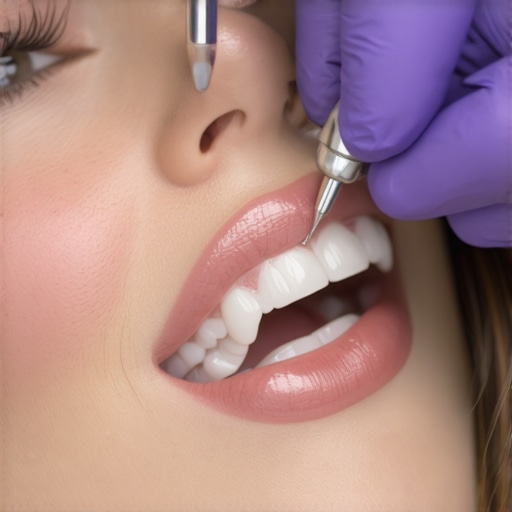My Journey to a Confident Smile: Discovering the Power of Invisalign and Crowns
As someone who’s always been conscious about my dental health, I remember the day I decided to finally address my crooked teeth. It was a mix of frustration and hope, especially after learning about options like Invisalign and crowns. I was eager to find solutions that not only improved my smile but also maintained its health over time. My experience taught me valuable lessons about maintaining oral health with these modern dental treatments, and I’d love to share some personal insights that could help you too.
Why I Chose Invisalign: Comfort and Confidence on the Go
Initially, I was overwhelmed by the idea of braces. But then I discovered Invisalign, which promised a discreet and comfortable way to straighten my teeth. The clear aligners fit snugly, and I appreciated how I could remove them during meals or when cleaning my teeth. This flexibility made a real difference in my daily routine. Plus, I found that regular check-ins with my dentist ensured my treatment stayed on track. For anyone considering orthodontic options, I highly recommend exploring Invisalign as it combines convenience with effectiveness. Curious about how Invisalign compares to traditional braces? Check out this detailed comparison.
Protecting My Investment: The Role of Dental Crowns
After my Invisalign journey, I had a few teeth that needed extra protection and strength—enter dental crowns. Crowns are truly a game-changer in restorative dentistry. They restored my teeth’s shape, function, and appearance, giving me the confidence to smile fully again. My dentist explained that crowns act like a shield, preserving the tooth underneath while preventing further damage. I appreciated how modern crown techniques provide durability and a natural look, making them a worthwhile investment for long-term oral health. For more insights into crowns, I recommend reading this comprehensive guide.
How Do I Maintain My Smile After Invisalign and Crowns?
Maintaining my results requires consistent oral hygiene habits. I brush at least twice a day, floss daily, and use mouthwash to keep my breath fresh. Regular dental check-ups are essential to catch any issues early. I also avoid excessively sugary or acidic foods that can erode enamel or damage crowns. Interestingly, I learned that good oral health is not just about treatments but about lifestyle choices. For example, I read that chewing sugarless gum can stimulate saliva, which helps protect teeth—more tips I found on this site.
What are the most common misconceptions about Invisalign and crowns?
This is a question I often get asked. Many people think that Invisalign takes too long or that crowns are only for cosmetic purposes. In reality, Invisalign can be quite efficient, especially with modern advancements, and crowns serve vital functional roles beyond aesthetics. To dispel myths and get accurate info, I recommend visiting this article.
If you’re considering these options or want to share your own experiences, I’d love to hear from you! Feel free to comment below or contact my trusted dental team for personalized advice. Taking proactive steps now can lead to a healthier, more confident smile for years to come.
Understanding the Long-Term Benefits of Invisalign and Crowns
As a seasoned dental professional, I often emphasize that the journey to a confident smile doesn’t end after completing Invisalign treatment or receiving dental crowns. These procedures lay the foundation for improved oral health and aesthetics, but maintaining their benefits requires ongoing care and awareness. Invisalign, with its discreet aligners, corrects misalignments efficiently, but it’s crucial to adhere to the prescribed wearing schedule and follow-up visits to ensure lasting results. Similarly, dental crowns are durable restorations, but their longevity hinges on proper oral hygiene and regular check-ups. For a comprehensive overview of how these treatments contribute to long-term oral health, visit this article on Invisalign’s future impact.
How Can You Optimize Your Post-Treatment Oral Hygiene?
Good oral hygiene practices are the cornerstone of preserving your smile’s health and appearance. Brushing at least twice daily with fluoride toothpaste, flossing daily, and using antiseptic mouthwash help remove plaque and prevent decay around crowns and aligners. I also recommend incorporating interdental brushes for hard-to-reach areas and considering water flossers for added cleaning efficiency. Lifestyle choices matter — avoiding sugary, acidic foods and beverages reduces enamel erosion and minimizes damage to crowns. Regular dental visits allow your dentist to monitor the integrity of your restorations and make timely adjustments. Want to learn more about personalized oral health routines? Check out top oral health tips here.
What Are the Hidden Factors That Influence Treatment Longevity?
Beyond routine care, several factors influence how long your Invisalign aligners and crowns last. These include your bite force, habits like teeth grinding (bruxism), and even your overall health. Patients with bruxism should consider night guards to protect their crowns and prevent undue wear on aligners. Additionally, smoking and poor diet can compromise oral tissues, affecting the success of restorative treatments. Understanding these nuances enables both patients and professionals to develop tailored care plans that extend the lifespan of dental work. To explore how to choose the right crown expert for durable results, visit this expert guide.
Can Innovative Technologies Enhance the Durability of Your Restorations?
Absolutely. Advances in dental materials and digital dentistry are revolutionizing how we approach restorations. High-strength ceramics and composite resins offer enhanced durability and a more natural appearance, especially when paired with CAD/CAM technology for precise fit and function. These innovations reduce the risk of chipping or cracking, ensuring your crowns and aligners last longer. By staying informed about emerging materials and techniques through trusted sources, you can make smarter choices for your oral health. For more insights into cutting-edge dental solutions, I recommend reading this article on crowns in modern dentistry.
If you’re eager to share your experience or have questions about maintaining your dental investments, I invite you to comment below. Sharing stories and tips can inspire others to prioritize their oral health and enjoy lifelong smiles.
Beyond the Basics: Navigating the Complexities of Long-Term Dental Investment
Reflecting on my own experiences, I’ve come to realize that maintaining the longevity of treatments like Invisalign and crowns involves more than just routine care; it’s about understanding the nuanced interplay between biology, technology, and lifestyle choices. For instance, I discovered that patients with certain genetic predispositions may require more tailored approaches to prevent early wear or failure of restorations. Recognizing these individual differences pushes us toward a more personalized dentistry, where treatments are adapted to each person’s unique needs.
The Subtle Art of Preventive Strategies: Protecting Your Smile’s Future
One lesson I’ve learned through continual research and patient interactions is that preventive measures can significantly extend the lifespan of dental work. Simple habits like avoiding biting on hard objects, managing stress-induced bruxism with custom night guards, and maintaining a balanced diet rich in calcium and vitamins can make a notable difference. I’ve seen cases where such proactive steps prevented the need for costly replacements or repairs, reaffirming that prevention is truly better than cure. For a comprehensive look at preventive practices, I recommend exploring top oral health tips.
Technological Innovations: Are They Changing the Rules of Durability?
Absolutely. The rapid evolution of dental materials and digital workflows has revolutionized restoration longevity. For instance, high-strength ceramics like zirconia, combined with CAD/CAM precision, offer remarkable resistance to chipping and fracturing—features I’ve observed firsthand in my clinical practice. These advancements are not just about aesthetics but about creating restorations that withstand the test of time. Staying informed about emerging technologies, such as bioactive materials that promote tooth regeneration, can help patients and practitioners make smarter choices. To delve deeper into these innovations, I suggest reading this article on crowns in modern dentistry.
How Can Patients Collaborate Effectively with Their Dentists for Long-Term Success?
Effective communication and shared decision-making are crucial. I’ve found that patients who ask questions, express concerns, and follow personalized care plans tend to enjoy better outcomes. For example, understanding the importance of regular check-ups, timely replacements, and lifestyle adjustments empowers individuals to take ownership of their oral health. Moreover, embracing new habits or technologies recommended by your dentist can significantly improve the durability of your restorations. If you’re curious about how to build a productive relationship with your dental team, visit this contact page for guidance.
What Are the Emerging Trends That Could Shape the Future of Restorative Dentistry?
Emerging trends like 3D printing of custom restorations, nanotechnology for enhanced material strength, and AI-driven diagnostics are poised to redefine longevity standards. These innovations promise not only more durable restorations but also more personalized, minimally invasive treatments. I anticipate that integrating these technologies will make dental care more accessible and effective, ultimately helping us preserve our smiles longer than ever before. For insights into how these trends are already impacting practices, check out this comprehensive overview.
Sharing your own experiences or questions about maintaining long-term dental health can inspire others on their journey. Feel free to comment below or reach out through this contact form. Together, we can foster a community dedicated to lifelong smiles and optimal oral wellness.
Harnessing Advanced Materials for Enhanced Restoration Longevity
In my extensive experience with restorative dentistry, I’ve observed that the selection of high-performance materials is crucial for maximizing the lifespan of crowns and aligners. Modern innovations like zirconia and lithium disilicate ceramics have revolutionized durability, offering resistance to chipping and fracturing while maintaining aesthetic appeal. As highlighted in a comprehensive review by the Journal of Prosthetic Dentistry, the evolution of bioinspired composites is paving the way for restorations that can mimic natural tissue resilience, thereby extending their functional life. Integrating these advanced materials into treatment plans not only elevates patient satisfaction but also reduces the need for frequent replacements, ultimately saving costs and preserving oral health over decades.
The Critical Role of Digital Dentistry and CAD/CAM Technologies
One of the most transformative developments in recent years is the advent of digital workflows. CAD/CAM (Computer-Aided Design and Computer-Aided Manufacturing) systems enable precise, custom-fit restorations that significantly enhance longevity. In my practice, employing digital impressions and milling techniques has resulted in superior marginal integrity, which is fundamental in preventing microleakage and secondary decay. This technological edge allows for meticulous planning and execution, ensuring restorations withstand the stresses of daily mastication. Moreover, the integration of 3D printing for provisional restorations accelerates treatment timelines without compromising quality. For those interested in exploring these innovations further, I recommend reviewing the detailed insights available at this article.

Personalized Preventive Strategies for Maximizing Restoration Lifespan
Preventive care remains the cornerstone of long-term success. Tailoring strategies to individual patient risk factors, such as bruxism, diet, and oral hygiene habits, can markedly improve outcomes. For instance, I advise patients with nocturnal grinding tendencies to use custom night guards, which distribute occlusal forces evenly and shield restorations from excessive wear. Dietary counseling to minimize acidic foods and beverages also plays a vital role, as enamel erosion can compromise the integrity of crowns and underlying structures. Staying vigilant through regular check-ups allows early detection of marginal deterioration or microfractures, enabling timely interventions. For a comprehensive overview of preventive techniques, my go-to resource is this guide.
Addressing the Impact of Biological and Lifestyle Factors
Understanding the biological and behavioral factors influencing restoration longevity is essential for both clinicians and patients. Conditions such as systemic diseases, nutritional deficiencies, and habits like smoking can impair healing and tissue health, accelerating restoration failure. From my clinical perspective, I emphasize the importance of holistic health management and lifestyle modifications alongside dental treatments. For example, patients with diabetes often experience delayed tissue healing, which can affect the integration and stability of crowns. Encouraging a balanced diet rich in calcium and vitamins, coupled with stress management techniques, can foster a healthier oral environment conducive to longer-lasting restorations. For more about these multifaceted considerations, I recommend reviewing this expert guide.
Things I Wish I Knew Earlier (or You Might Find Surprising)
The Power of Personalization
One insight I’ve gained over years of working with dental patients is how vital personalized care is. Every smile is unique, and treatments like Invisalign and crowns work best when tailored to individual needs. I used to think a one-size-fits-all approach was sufficient, but understanding my own oral habits and biological factors made a huge difference in maintaining long-term results.
The Subtle Impact of Lifestyle Choices
Small daily decisions—like avoiding sugary drinks or not grinding teeth at night—can significantly extend the life of restorations. I was surprised to learn that habits such as smoking or poor diet don’t just affect general health but can also cause crowns to wear out faster or aligners to become less effective. It’s a reminder that maintaining a healthy lifestyle is an integral part of dental success.
The Limitations of Modern Materials
While high-tech materials like zirconia and lithium disilicate are incredibly durable, they are not invincible. I’ve seen cases where neglecting proper hygiene or ignoring early signs of damage led to costly repairs. Awareness of these limitations encourages proactive care, which truly preserves your investment in your smile.
The Role of Technology in Longevity
Digital dentistry, especially CAD/CAM systems, has revolutionized how durable restorations are. Precise fits reduce microleakage and secondary decay, which are common causes of failure. I find that staying updated on these innovations helps in making smarter choices for long-lasting results.
The Hidden Benefits of Preventive Care
Regular check-ups and cleanings aren’t just about maintaining aesthetics—they also catch issues early before they become expensive problems. I personally noticed that consistent preventive care kept my crowns and aligners in top shape longer, saving me time and money.
My Final Reflection
In my experience, the journey toward a confident smile is ongoing. Combining modern treatments like Invisalign and crowns with mindful lifestyle habits and technological advances creates a foundation for lasting oral health. If you’re considering these options, remember that informed choices and proactive care make all the difference. I encourage you to explore trusted resources like this article to deepen your understanding. If this resonates with you, I’d love to hear your thoughts or personal stories—feel free to share below or reach out to your dental professional. Your smile is worth the effort, and with the right knowledge, you can enjoy it for a lifetime.

